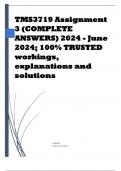TMS3719 Assignment
3 (COMPLETE
ANSWERS) 2024 - June
2024; 100% TRUSTED
workings,
explanations and
solutions
ADMIN
[COMPANY NAME]
,Question 1 1.1. The Curriculum and Assessment Policy Statement
(CAPS) (2011) states that “listening and speaking are different but
co-dependent skills”. Explain how you would teach ‘summarising’
and ‘paraphrasing’ during the listening process. Use examples to
illustrate your answer. (4) 1.2. According to the CAPS (2011:19),
“listening instruction involves working through elements of the
listening process”. 3 Copy/scan and paste a suitable listening text
into your assessment and explain, with reference to the listening
text, how you would implement the three stages of listening. (15)
1.3. Distinguish between the following types of listening. Explain
how they will benefit language learners. 1.3.1. Listening for critical
analysis 1.3.2. Listening for interaction 1.3.3. Listening for
appreciation 1.3.4. Listening for specific purposes (12) (31)
1.1. Teaching ‘Summarising’ and ‘Paraphrasing’ During the
Listening Process
Summarising and paraphrasing are essential skills that support
comprehension and retention of spoken information. Here's how you
can teach these skills during the listening process:
Summarising:
1. Introduce the concept: Explain to students that summarising
involves condensing the main ideas of a spoken text into a
shorter version, capturing the key points without the details.
2. Model the skill: Play a short audio clip, then demonstrate
summarising it by identifying the main ideas and writing a
brief summary.
, 3. Guided practice: Play another audio clip. Guide students
through the process of identifying the main points and writing
a summary together.
4. Independent practice: Assign a new audio clip for students to
listen to individually and write their own summaries.
5. Feedback: Review the summaries and provide feedback,
highlighting effective summaries and areas for improvement.
Example: If the audio is about the importance of recycling, the
summary might be: "The speaker explains that recycling reduces
waste, conserves natural resources, and helps protect the
environment."
Paraphrasing:
1. Introduce the concept: Explain that paraphrasing involves
rephrasing the spoken text in their own words while retaining
the original meaning.
2. Model the skill: Play a sentence or short passage from an
audio clip, then demonstrate paraphrasing it.
3. Guided practice: Play another audio clip. Work with students
to paraphrase specific sentences or sections together.
4. Independent practice: Assign a new audio clip for students to
listen to and paraphrase selected parts.
5. Feedback: Review the paraphrases and provide feedback,
focusing on maintaining the original meaning while using
different words and structures.
Example: If the original sentence is "Recycling can significantly
reduce the amount of waste that ends up in landfills," a paraphrase
might be: "By recycling, we can greatly decrease the volume of
trash that is disposed of in dumps."
1.2. Implementing the Three Stages of Listening




